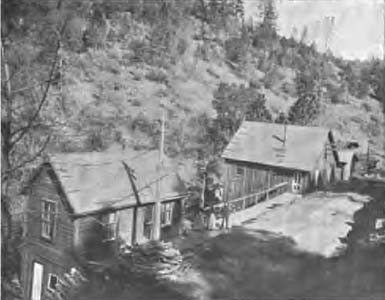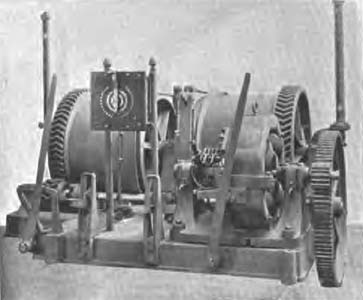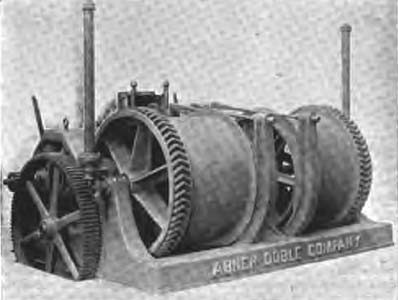[Trade Journal]
Publication: Mining Resources of Calaveras County
San Francisco, CA, United States
p. 61-64
EXTRACT FROM ELECTRICITY AND MINING
Though Calaveras County is bountifully supplied with electric power from the electric plant of the Blue Lakes Water Company, situated on the Mokelumne River, and although several water powers are eligible for electric transmission plants, there is but one electric station of importance within the county, and this is that of the Utica Mining Company of Angels Camp. This plant, which is illustrated herewith, was installed in January, 1895, largely for the purpose of deriving experience in the application of electricity for lighting and power purposes in the Utica Mine before making expenditures that would be necessary for the installation of a new plant that would fully satisfy the company's requirements. Though this original plant is simple in the extreme, it has fulfilled its purposes, and will probably be shortly superseded by one of the largest mining electrical installations in the world. The company owns the water power of 2000 miners inches, from which is obtained a fall of 570 feet in 1750 feet of pipe line. The present electrical plant uses about 150 inches of water of the 3000 horse power available. The power derived from a 6-foot tangential Dodd wheel is belted to a 1500-light 2500-volt Westinghouse alternator, whence the current is carried over a circuit of 1 B. & S. gauge, bare copper wire to the mine situated about 1000 feet below the plant, where it used for lighting purposes, there being 25 alternating current constant potential arc lamps and 1250 incandescents. The exciter is driven by a separate 12-inch Dodd wheel.
| |||
| Buildings at Blue Lake City. |
It is probable that at an early date the large installation referred to will be undertaken, when 3000 horsepower will be generated and transmitted to the mine and thereabouts. The length of transmission will 'be about 8J miles, and the system will consist of 2-phase generation, 3-phase transmission, and various distributions. Five hundred horse-power will be utilized in air compression, two 2o-stamp mills will require 150 horse-power each, and one 250-horse-power rotary transformer will generate low potential direct current to be used for power purposes down the shaft. Six 500 horse-power units to operate in parallel or singly, as deemed advisable, will be installed, and the transmission will be at 10,000 volts. In addition to the purposes named, two sawmills, together with machine shops, rock breakers, etc., will be operated by electric power.
| |||
| Interior of Blue Lakes Electric Plant. |
The entire output of the transmission plant just described will, as stated, be used in and about the Utica Mine; but the needs of the other mining interests throughout Calaveras County for electric power are amply satisfied by the electric transmission line of the California Exploration Company, which is supplied with electric current from the power plant of the Blue Lakes Water Company by contract. This plant was exhaustively described in a profusely illustrated and authorized article appearing in the Journal of Electricity for October, 1896. In general, however, it consists of three 600 horse-power, Stanley, 2-phase inductor type generators, driven by 40-inch Doble tangential water wheels operated under a head of 1042 feet, water for the same being taken from the Amaclor Canal by the Blue Lakes Water Company.
| |||
| Front View of the Gottschalk Hoist. |
The cost of mining development in Calaveras County has been high on account of the expense of fuel, which ranges from $4.50 to $5.50 per cord, and without water power, and with high charges for wood, mine development has been possible only for wealthy corporations, but after an exhaustive study of the means available for furnishing power for the exploration and operation of its mines, and after a thorough canvass of the various water powers available, the California Exploration Company resolved upon electricity as the most feasible power, and entered into a thirty years' contract with the Blue Lakes Water Company, under which the Exploration Company has the exclusive right for the transmission and distribution of electric power and light from the Blue Lakes plant in Calaveras County. This contract comtem- plates the use of from 1000 horse-power up, and really forms the basis for the building of the Blue Lakes plant. The Calaveras pole line is of the most substantial type. Thirty-five foot selected redwood poles are used throughout, measuring 10x10 at the butt by 6x6 at the top, and being sunk 6 feet in the ground. Two 22-inch cross arms, gained 18 inches between centers, are used, and at curves these cross arms are doubled and framed together. All poles on curves are firmly guyed to inverted "T" guy stubs consisting generally of 8x8 redwood. Two No. 3 B. & S. gauge wires are placed on each cross car at a separation of 18 inches, and of the 4 wires carried by the 2 cross arms, the diagonal wires are phases. Locke triple petticoat china insulators are used throughout. The line is not transposed. At the tops of the poles, supported by porcelain knobs, and grounded at irregular intervals, is run a close-barbed galvanized iron fence wire. This ground wire continues over the entire pole line, and its object is to facilitate the grounding and dispersion of static charges, thereby minimizing liability of lightning stroke. From the power house, which is situated on the north side of the Mokelunme River, the line is taken up a mountain side for a distance of one mile to the Exploration Company's sub-station in Mokelumne Hill, in which town there is nine-tenths of a mile of poleline for lighting distribution purposes. The next substation is in the town of San Andreas, which is 7.7 miles distant by way of the pole line from the sub-Nation h Mokelumne Hill. The town lighting in San Andreas embraces 2.03 miles of pole lines for low tension distribution, and from the sub-station the transmission line continues on a distance of 7.05 miles to the Bund Mine, to which the high potential circuit is now completed. The total length of the Exploration Company's transmission line is at present 19.11 miles, and in all probability the circuit will soon be extended to Angels Camp, which is about five miles beyond the Bund mine.
| |||
| Rear View of the Gottschalk Hoist. |
One of the most interesting electrical features in connection with the transmission circuit of the California Exploration Company is the mode of operating the double compartment electric hoist in operation at the Gottschalk mine near San Andreas. This hoisting installation is so unique that it is believed a detailed technical description of its modus operandi will be of interest.
(article continues)




